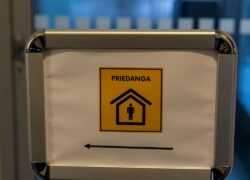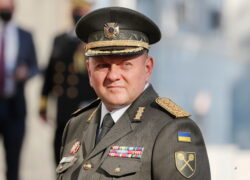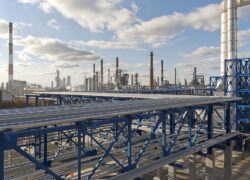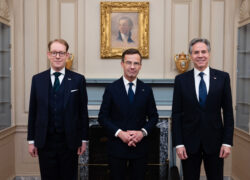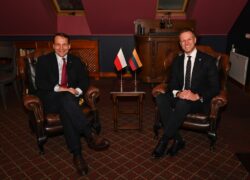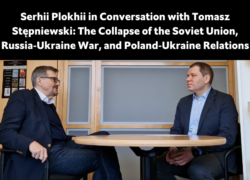Over the last two years, due to the ongoing Russian-Ukrainian war, Lithuania has amended the law on crisis management and civil protection. A review of existing collective protection facilities was carried out and activities to create new shelters were intensified. The current infrastructure, adapted to provide temporary protection for the population in times of emergency or war, allows the guarantee of safety for approximately 30% of all Lithuanian inhabitants.
Insufficient collective protection infrastructure in Lithuania. Even though legal acts on civil security in Lithuania stipulated that all municipalities should have collective protection facilities that could be used in crisis situations, in 2018, out of 60 municipalities (districts), only 9 had such buildings, and 35 had shelters that met the established requirements only partially. At the beginning of February 2022, the State Audit Office (Valstybės kontrolė), the key audit institution in the country, prepared a report for 2018-2020, assessing the readiness of the public institutions for effective crisis management (Valstybinio audito ataskaita institucijų pasirengimas reaguoti į extremeliąsias situacijas). The document revealed that not all audited institutions were adequately prepared for possible threats. There was a lack of clarity regarding their competencies and responsibilities as well as relevant legal regulations. Moreover, interinstitutional cooperation and coordination of activities were insufficient, and any threat and risk assessment was underdeveloped. After analysing data from six selected municipalities in Lithuania regarding collective protection facilities, it was found that four of them did not provide adequate infrastructure in the event of emergencies. During that period, the location and size of hiding places were determined on the basis of the sum of 10% of the number of inhabitants of a given municipality, the number of children under 7 years of age, and the number of disabled people.
Legal changes. After the outbreak of the full-scale Russian-Ukrainian war, the applicable regulations were revised and actions were taken to develop protective infrastructure. On 29 December 2023, the Act on Crisis Management and Civil Protection (Lietuvos Respublikos krizių valdymo ir civilinės saugos įstatymas) entered into force, which defined the rules for preventing, managing, and removing the consequences of crises and emergency situations. It was established that public institutions and economic entities are obliged to provide municipalities with information about facilities and premises that may serve as shelters. These entities were also obliged to provide the hiding places free of charge in the case of a threat. After numerous consultations with representatives of local governments, civil protection experts, and military specialists, and after reviewing international practice, on 28 February 2024, the Ministry of the Environment issued a regulation on the requirements for the design and construction of collective protection facilities (Dėl statybos techninio reglamento STR 2.07.02:2024 “Slėptuvės, kolektyvinės apsaugos statinio ir priedangos projektavimo ir įrengimo reikalavimai” patvirtinimo), covering buildings whose purpose is to ensure the durability of the functioning of the state in a situation of military aggression, including buildings of state institutions, hospitals, and state-owned enterprises of strategic importance. Additionally, an obligation was introduced to design and install shelters in all newly constructed public buildings intended for more than one hundred people and in multi-story residential buildings (over 5 floors). Requirements were specified regarding the strength of the structure, materials, room size (1.5 sqm per person), the minimum number of persons protected (60% of the institution’s users or residents in the case of a residential building), and engineering systems (such as heating, ventilation, electronic communications, water supply and sewage installations, electrical systems, and others). The exception is buildings intended for religious purposes, where shelters must be designed in their underground construction and the rooms must be publicly accessible. The agreement, signed by the Ministry of Interior and the Catholic Church in Lithuania, provides for public education and the adaptation of religious buildings for civilian purposes in crisis situations (as of September 2023, 10 churches in Lithuania could perform such functions). Church buildings can also be used to install warning devices.
In mid-2023, the rules managing technical standards for the construction and use of shelters were amended to clarify the conditions and raise the requirements for the construction of these facilities. For example, in relation to the 2010 law on civil protection, the minimum number of inhabitants to whom protective infrastructure should be provided has been increased. Now it is determined based on the sum of 25% of the population of a given municipality, the number of children under 7, the number of elderly people covered by social care, and the number of disabled people living in a given municipality. Additionally, the state institutions such as the Parliament, ministries, state security services, border guards, police and others, are to have shelters. The time to reach the nearest collective security facility should be 5 to 7 minutes from the alarm signal. According to the current law, municipalities are responsible for the selection, marking, and preparation of shelters, and the activities are coordinated by the Department of Fire Protection and Rescue at the Ministry of Interior.
Plans to expand the shelter system. Currently, Lithuanian legislation distinguishes between shelters, which are special-purpose facilities intended to protect the population in times of emergency or war, and collective protection buildings such as schools, kindergartens, and cultural and sports centres, which perform public functions on a daily basis, but in case of danger, can be adapted as a temporary shelter for residents. According to estimates of the Ministry of Interior, the current civil protection infrastructure covers a total of over 3.3 thousand shelters that can accommodate 912,000 inhabitants of Lithuania, which constitutes 31% of the population. The government also wants to expand buildings that serve a protective function during threats, so that 60% of residents of urban municipalities and 40% of other districts have access to protective infrastructure. So far, only 12 municipalities in Lithuania have achieved this level[1], but a dozen or so [more] municipalities are already approaching the set level. The Ministry of Interior announced that the relevant services will soon inspect all such hiding places and assess their condition.
Conclusions. Before Russia’s full-scale attack on Ukraine, the development of collective protection infrastructure was not a priority in Lithuania’s security policy, but the war intensified the government’s activities in this area (ICE Commentaries No. 871, ICE Commentaries No. 1074). The law was amended and projects related to the construction and modernization of the existing civil security infrastructure were initiated. Currently, only some local governments have facilities that meet the designated standards, but the Department of Fire Protection and Rescue emphasises that Lithuania is a leader in the development of shelters among the Baltic states. Over the last two years, the number and availability of shelters have increased by almost half; in 2022, there were 1.8 thousand such facilities to protect approximately half a million citizens or 17% of the population.
Currently, the main challenge is to create new buildings and adapt existing ones for the protection of civilians. Therefore, further actions are necessary to finance part of the renovation and construction works. Challenges also include insufficient access of citizens to information on both procedures during crisis situations and the location of shelters. Therefore, it is crucial to strengthen the public information system (e.g., website lt72.lt) as well as to further improve the competencies of not only officers but also residents in the field of civil protection.
The state plays a fundamental role by shaping the legal framework, identifying potential threats and developing the infrastructure necessary to prevent and manage them. However, it is equally important to build a strong civil society in which each resident has the necessary knowledge and skills to act effectively in crisis situations.
[1] In the southern part of Lithuania – Birštonas and Druskininkai regions; in the south-west – Vilkaviškis district; in the western part – the Šilalė, Šakiai, and Pagėgiai districts; in the central part – the Raseiniai, Kazlų Rūda, Kaišiadorys, Prienai, Kėdainiai, and Kaunas districts. Alla of these are district municipalities.

